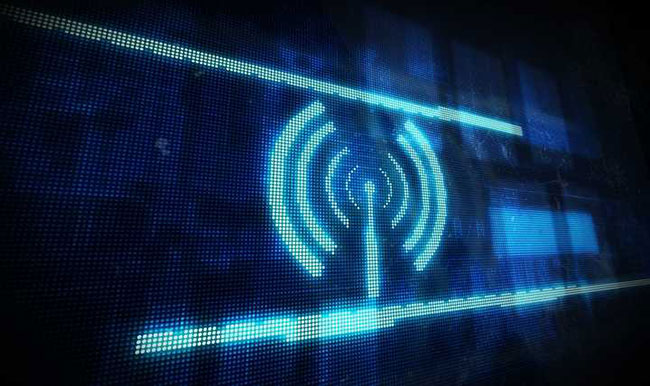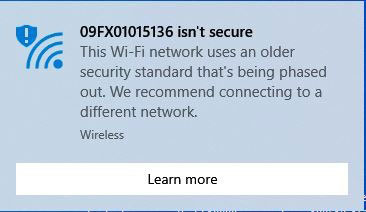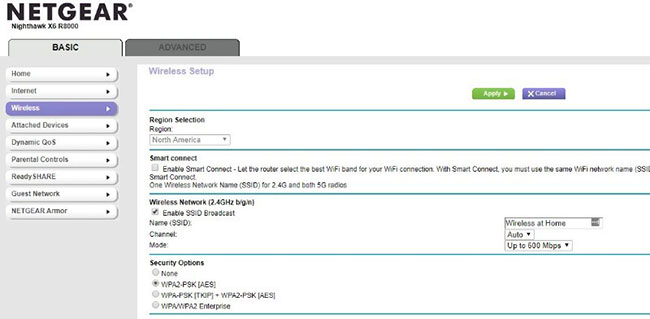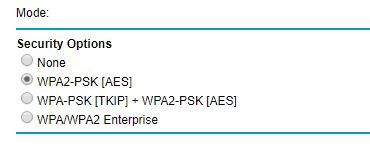How to fix 'Your Wi-Fi Network Isn't Secure' error on Windows
Nowadays, almost everyone knows that protecting network passwords is extremely important. You don't want anyone to have access to your network, whether it's just a neighbor who wants to use the free Internet or a hacker trying to steal your information. You also don't want to be touched by the police just because other people use your network for nefarious purposes, right?
Passwords are not the only protection your network needs. It also needs strong encryption so no one can intercept the data.

WiFi encryption protocols
Since 1999, when WiFi Alliance approved the first WiFi encryption protocol, WEP, there have been many updates to improve the technology. However, despite all the advancements in encryption, some people still use this outdated original protocol.
There are many different encryption methods used to protect WiFi networks: WEP, WPA and WPA2. WiFi Alliance has just started certifying new products using the new WPA3 technology. Each new protocol has improved security over the previous one, making your network more secure.
- Compare 4 types of WiFi security WEP, WPA, WPA2 and WPA3
However, older versions are still available and, unfortunately, still widely used. WEP has never been a good choice for encryption, even if it was first released. The Wi-Fi Alliance abandoned this encryption method in 2004. A year later, the FBI demonstrated that hackers could easily crack WEP encryption by exploiting many of its vulnerabilities.
The Wi-Fi Alliance had planned to replace WEP with WPA-TKIP, but that protocol worked in a way very similar to the original one. It has many similar vulnerabilities. If you can crack one, it can often be cracked.
Warning 'Wi-Fi Isn't Secure' of Windows
Windows recently added an alert that appears when you try to connect to a network that is protected by one of the older encryption protocols. This message is for your safety and serves as a warning, especially if you are running Windows 10, that you will soon be unable to connect to these less secure protocols anymore.

This warning states:
'[Network Name] isn't secure.This Wi-Fi uses an older security standard that's being phased out. We recommend connecting to a different network '.
(The network name is [unsecured]. This WiFi uses an old security standard that is being phased out. We recommend connecting to another network.)
This message tells you that you are trying to connect to a network that is still using WEP or WPA-TKIP encryption.
How to fix the problem
If you see this message when trying to connect to your home network, you should be able to fix the problem by turning on newer, strong encryption methods.
Each router has a different method to change security protocols, so you may have to check the manufacturer's website to find the exact location of this option.
1. Enter the router's IP address in the browser address bar or if you have a Netgear router, you can enter routerlogin.net to access the router.
2. Log in to the router with the username and password. If no password is set, check the router manufacturer's website for the default password.
3. Locate the web interface. It will look like the following image.

4. Select the most powerful encryption protocol available on the router.

The following is a list of encryption protocols available on most modern routers manufactured after 2006. They are sorted from most secure to least secure.
- Any WPA3 (This option is only available on the latest routers as it has just appeared).
- WPA2 + AES
- WPA + AES
- WPA + TKIP / AES
- WPA + TKIP
- WEP
If you don't see any options better than WEP or WPA + TKIP, it's best to buy a new router. There are many reasonably priced models available that can meet the requirements for a mid-sized home, with up to 20 WiFi devices.
Regardless of what you do to stop using these outdated protocols, you should do this as quickly as possible. Not only are they easily compromised, but they can also be used on Windows devices soon.
You should read it
- What is Network TAP? How does it help secure the system?
- How to Set Up and Use SSH in Linux
- 5 best WiFi analyzer tools to check if the network is secure
- Super secure SIM card, only connecting data via Tor anonymity network helps protect information for users
- Secure WiFi in enterprise environment from basic steps
- Katim Phone - what's the most secure phone in the world?
- Multiple choice questions on network security deployment have the answer P6
- Don't believe 7 'myths' about this SSL and HTTPS certificate
May be interested
- Common network connection errors and solutions
 if your network connection is misconfigured or technical error, you will see some error messages displayed on the screen. these messages tell the user basic information about the problem. the following list of common connection-related errors will be useful in troubleshooting network problems.
if your network connection is misconfigured or technical error, you will see some error messages displayed on the screen. these messages tell the user basic information about the problem. the following list of common connection-related errors will be useful in troubleshooting network problems. - Steps to fix errors 0xc0000225 on Windows Vista / 7/8 / 8.1 / 10
 have you ever received an error message when starting windows vista, 7, 8, 8.1 or windows 10 computers: '0xc0000225: an unexpected error has occurred'? in the article below, network administrator will guide you through several ways to fix this error.
have you ever received an error message when starting windows vista, 7, 8, 8.1 or windows 10 computers: '0xc0000225: an unexpected error has occurred'? in the article below, network administrator will guide you through several ways to fix this error. - Instructions for troubleshooting Windows 7 network errors
 setting up and maintaining home network is easier than ever with windows 7 operating system. however, this is not true. there are still many unresolved network related issues in the windows 7 control panel.
setting up and maintaining home network is easier than ever with windows 7 operating system. however, this is not true. there are still many unresolved network related issues in the windows 7 control panel. - How to fix network errors in ChatGPT
 the network error in chatgpt is a good example. it pauses your conversation with the chatbot, forcing you to reopen it and start over. this error is really annoying, but why does it happen? is there any way to fix the error?
the network error in chatgpt is a good example. it pauses your conversation with the chatbot, forcing you to reopen it and start over. this error is really annoying, but why does it happen? is there any way to fix the error? - How to check and fix DNS leak error in VPN
 when using a secure connection like a vpn tunnel, a dns leak error occurs when dns requests are sent over a normal (unencrypted) network instead of a secure tunnel.
when using a secure connection like a vpn tunnel, a dns leak error occurs when dns requests are sent over a normal (unencrypted) network instead of a secure tunnel. - Instructions to fix Windows error does not boot
 if you see your windows computer displaying error messages before loading into windows operating system, boot sector is likely to be corrupted, corrupted or missing files. in the following article, network administrator will introduce and guide you to some solutions as well as the steps to take to fix windows failures to boot.
if you see your windows computer displaying error messages before loading into windows operating system, boot sector is likely to be corrupted, corrupted or missing files. in the following article, network administrator will introduce and guide you to some solutions as well as the steps to take to fix windows failures to boot. - How to fix 'Network Resource Unavailable' error on Windows
 it's frustrating when you're trying to share files on your local network or update your software to the latest version but you can't.
it's frustrating when you're trying to share files on your local network or update your software to the latest version but you can't. - [Infographic] 5G network security: What service providers need to know
![[Infographic] 5G network security: What service providers need to know](https://tipsmake.com/img/no-image-80-80.png) with such influence, the security risks and security that 5g brings are also great. the cisco infographic below will show you the basic information about 5g security for network service providers.
with such influence, the security risks and security that 5g brings are also great. the cisco infographic below will show you the basic information about 5g security for network service providers. - How to fix error 0x0000011b when printing over the network on Windows 10
 if you encounter an error that cannot print over the network, error code 0x0000011b, then this article will give you a solution.
if you encounter an error that cannot print over the network, error code 0x0000011b, then this article will give you a solution. - 5 best tools to detect 'errors' on the network you are using
 on a beautiful day, suddenly you feel that the speed of your home's internet connection is no different from that of a cow or your network suddenly experiencing a problem .... you wonder if anyone are you accessing and using your network, or are there any errors on your network?
on a beautiful day, suddenly you feel that the speed of your home's internet connection is no different from that of a cow or your network suddenly experiencing a problem .... you wonder if anyone are you accessing and using your network, or are there any errors on your network?







![[Infographic] 5G network security: What service providers need to know](https://tipsmake.com/data/thumbs_80x80/[infographic]-5g-network-security-what-service-providers-need-to-know_thumbs_80x80_WBkbsdCOZ.jpg)


 How to rebuild BCD in Windows
How to rebuild BCD in Windows How to fix a Windows 10 laptop error with the wrong battery percentage displayed
How to fix a Windows 10 laptop error with the wrong battery percentage displayed Fix 0xc00000e9 error in Windows
Fix 0xc00000e9 error in Windows How to fix problems with multi-monitor setup in Windows
How to fix problems with multi-monitor setup in Windows How to fix LogiLDA.dll error message in Windows
How to fix LogiLDA.dll error message in Windows Learn about error code 0xc0000001
Learn about error code 0xc0000001